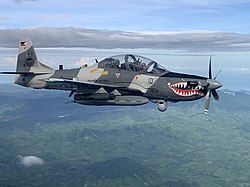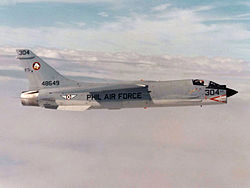Gallery
- A PAF FA-50PH equipped with GBU-12 Paveway II laser guided bombs, AGM-65G2 Maverick AGMs, and the AIM-9L/I-1 Sidewinder AAMs
- Two PAF's FA-50PH fighter jets
- PAF EMB 314 Super Tucano
- A PAF OV-10M Bronco
- A PAF T129B ATAK
- A PAF AH-1S Cobra, with a trio of Cessna T-41 Mescalero in the background
- A PZL W-3 Sokół of the 505th Search and Rescue Group
- PAF S-70i Black Hawk
- A CASA NC-212i light transport aircraft approaching Clark International Airport
- A pair of Lockheed C-130 Hercules at Villamor Air Base
- Philippine Air Force SPYDER medium range air defence system
- A M39 cannon platform being towed by a Kia KM450 light truck














